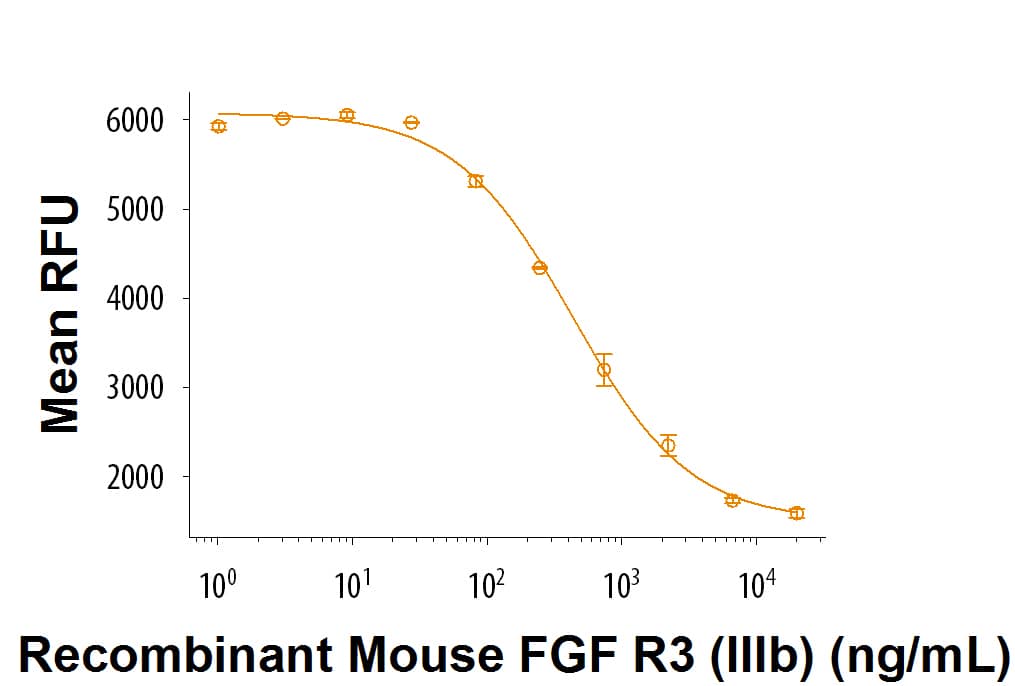Recombinant Mouse FGFR3 alpha (IIIb) Fc Chimera Protein, CF Summary
Product Specifications
| Mouse FGF R3 (IIIb) (Ala33-Tyr369) Accession # NP_001156689 |
IEGRMD | Human IgG1 (Pro100-Lys330) |
| N-terminus | C-terminus | |
Analysis
Product Datasheets
Carrier Free
CF stands for Carrier Free (CF). We typically add Bovine Serum Albumin (BSA) as a carrier protein to our recombinant proteins. Adding a carrier protein enhances protein stability, increases shelf-life, and allows the recombinant protein to be stored at a more dilute concentration. The carrier free version does not contain BSA.
In general, we advise purchasing the recombinant protein with BSA for use in cell or tissue culture, or as an ELISA standard. In contrast, the carrier free protein is recommended for applications, in which the presence of BSA could interfere.
9089-FR
| Formulation | Lyophilized from a 0.2 μm filtered solution in PBS. |
| Reconstitution | Reconstitute at 500 μg/mL in PBS. |
| Shipping | The product is shipped at ambient temperature. Upon receipt, store it immediately at the temperature recommended below. |
| Stability & Storage: | Use a manual defrost freezer and avoid repeated freeze-thaw cycles.
|
Scientific Data
 View Larger
View Larger
Recombinant Mouse FGF R3 (IIIb) Fc Chimera (Catalog # 9089-FR) inhibits Recombinant Mouse FGF acidic (Catalog # 4686-FA)-dependent proliferation of Human FGF R3 (IIIc) transfected BaF3 mouse pro‑B cells. The ED50 for this effect is 0.2-1.2 μg/mL.
Reconstitution Calculator
Background: FGFR3
Fibroblast growth factor receptor 3 (FGF R3), also known as CEK2 and CD333, is an approximately 120 kDa transmembrane receptor tyrosine kinase that plays a role in skeletal development and tumorigenesis (1). Mature mouse FGF R3 (IIIc) consists of a 349 amino acid (aa) extracellular domain (ECD) with three Ig-like domains, a 21 aa transmembrane segment, and a 411 aa cytoplasmic domain that contains the tyrosine kinase domain (2). Alternative splicing generates an additional isoform (IIIb) with a substitution in the third Ig-like domain (3). Within the ECD, mouse FGF R3 (IIIb) shares 91% and 98% aa sequence identity with comparable isoforms of human and rat FGF R3, respectively. The FGF R3 (IIIb) triggers cell proliferation in response to FGF acidic and FGF-9, while FGF R3 (IIIc) shows a wider selectivity that includes FGF acidic, FGF basic, FGF-4, -8, -9, -17, -18, -19, and -20 (4, 5). Ligand binding induces receptor dimerization and acitvation of the tyrosine kinase domain (1). FGF mediated activation of FGF R3 is dependent on the presence of heparan sulfate proteoglycans (6). FGF R3 functions as a negative regulator of endochondral bone growth, and FGF R3 mutations are associated with chondrodysplasia in humans (7, 8). In addition, the development of many cancers is associated with mutations or dysregulation of FGF R3 which can result in constitutive receptor activation (1).
- Turner, N. and R. Grose (2010) Nat. Rev. Cancer 10:116.
- Katoh, O. et al. (1993) Cancer Res. 53:1136.
- Chellaiah, A.T. et al. (1994) J. Biol. Chem. 269:11620.
- Ornitz, D.M. et al. (1996) J. Biol. Chem. 271:15292.
- Zhang, X. et al. (2006) J. Biol. Chem. 281:15694.
- Ornitz, D.M. and P. Leder (1992) J. Biol. Chem. 267:16305.
- Deng, C. et al. (1996) Cell 84:911.
- Colvin, J.S. et al. (1996) Nat. Genet. 12:390.
FAQs
No product specific FAQs exist for this product, however you may
View all Proteins and Enzyme FAQsReviews for Recombinant Mouse FGFR3 alpha (IIIb) Fc Chimera Protein, CF
There are currently no reviews for this product. Be the first to review Recombinant Mouse FGFR3 alpha (IIIb) Fc Chimera Protein, CF and earn rewards!
Have you used Recombinant Mouse FGFR3 alpha (IIIb) Fc Chimera Protein, CF?
Submit a review and receive an Amazon gift card.
$25/€18/£15/$25CAN/¥75 Yuan/¥2500 Yen for a review with an image
$10/€7/£6/$10 CAD/¥70 Yuan/¥1110 Yen for a review without an image




